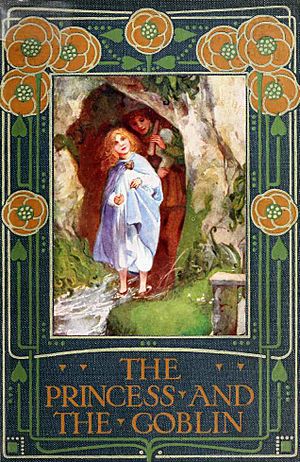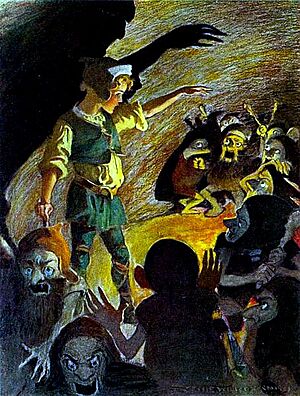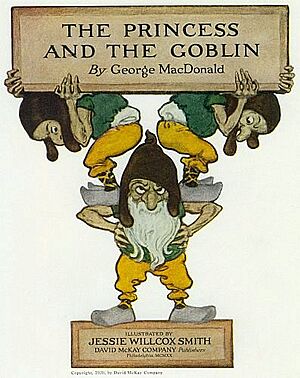The Princess and the Goblin facts for kids

Cover of the 1911 Blackie and Son edition, illustrator uncredited
|
|
| Author | George MacDonald |
|---|---|
| Illustrator | Arthur Hughes (serial and 1872 book) |
| Country | United Kingdom |
| Genre | Children's fantasy novel |
| Publisher | Strahan & Co |
|
Publication date
|
1872 |
| Media type | |
| Pages | 308, 12 plates (1911, Blackie and Son, above) |
| Followed by | The Princess and Curdie |
| Text | The Princess and the Goblin at Wikisource |
The Princess and the Goblin is a classic children's fantasy novel. It was written by George MacDonald and first came out in 1872. The book features black-and-white drawings by Arthur Hughes. Before it was a book, the story was published in parts. It appeared in a magazine called Good Words for the Young starting in November 1870.
Many people love this story. One writer, Anne Thaxter Eaton, said the book and its sequel teach about courage and honor. Another writer, Jeffrey Holdaway, noted that the books start like normal fairytales. But they slowly become stranger and have deep meanings, much like the works of Lewis Carroll.
Contents
Story Overview: A Royal Adventure
This section tells you what happens in the book. It's about a brave princess and a young miner. They face dangers from strange creatures living underground.
Princess Irene's Lonely Life
Eight-year-old Princess Irene lives in a big castle. Her home is in a wild, mountainous land. She often feels lonely, with only her nursemaid, Lootie, for company. Her father, the king, is usually away. Her mother has passed away.
The Secret of the Goblins
Unknown to Irene, a group of goblins lives in the nearby mines. These goblins were once banished from the kingdom. Now, they want to get revenge on the humans.
A Mysterious Discovery
One rainy day, Princess Irene explores her castle. She finds a beautiful, mysterious lady. This lady says she is Irene's great-great-grandmother. She shares the same name as the princess.
Meeting Curdie, the Miner
The next day, Irene convinces her nursemaid to go outside. As it gets dark, goblins chase them. A young miner named Curdie rescues them. Irene quickly becomes friends with him.
Curdie's Brave Discovery
Curdie works in the mines. He overhears the goblins talking. He learns their secret weakness: their feet are very soft and sensitive. Curdie then sneaks into the goblin palace. He listens to their meeting. He finds out the goblins plan to flood the mine if their other plan fails. He tells his father about this danger.
Irene's Magic Thread
Back at the palace, Princess Irene hurts her hand. Her great-great-grandmother heals it. A week later, Irene wants to see her great-great-grandmother again. But a long-legged cat frightens her. She runs up the mountain. A light from her great-great-grandmother's tower guides her home. Her great-great-grandmother gives Irene a special ring. It has a thread that only Irene can see. This thread always connects her to home.
Curdie's Fight with the Goblins
Curdie explores the goblins' underground home. The goblins find him. He bravely stamps on their soft feet, which works well. But when he tries to stamp on the Goblin Queen's feet, she is not hurt. She wears stone shoes. The goblins capture Curdie. They think he will starve.
Irene to the Rescue
Irene's magic thread leads her to Curdie. She rescues him. Curdie then steals one of the Goblin Queen's stone shoes. Irene takes Curdie to meet her great-great-grandmother. But Curdie cannot see her, only Irene can.
The Goblins' Evil Plan
Curdie soon learns the goblins are digging a tunnel. It goes from the mines to the king's palace. They plan to kidnap Princess Irene. They want her to marry the goblin prince, Harelip. Curdie warns the palace guards. But they don't believe him and put him in prison. He gets a fever from a leg wound. Irene's great-great-grandmother heals him.
The Final Battle
The goblins break through the palace floor. They come to take the princess. But Curdie escapes his prison room. He stamps on the goblins' feet. The goblins retreat. Everyone thinks Irene is captured. But Curdie follows the magic thread. It leads him to his own house, where Irene is safe. He brings her back to the king.
The Flood and the Reward
When the goblins flood the mines, the water enters the palace. Curdie warns everyone. The goblins are drowned by the flood. The king asks Curdie to be his bodyguard. But Curdie says he must stay with his parents. Instead, he accepts a new red petticoat for his mother as a reward.
Movie Versions of the Story
The Princess and the Goblin has been made into movies and TV shows. Here are some of them.
Early Animated Show
In the 1960s, Jay Ward made an animated version. It was part of his Fractured Fairy Tales series. In this version, the goblins were innocent. They were forced to live underground. An ugly goblin king falls in love with a beautiful princess. But a prince saves her by reading poetry, which goblins hate.
The 1992 Animated Film
A full-length animated movie based on the book came out in 1992. It was directed by József Gémes. This movie was made by companies from Hungary, Wales, and Japan. It featured the voices of famous actors like Joss Ackland and Rik Mayall. Robin Lyons, the film's producer, also wrote the script and voiced the Goblin King. The movie did not do very well when it was released in the US in 1994. It made less money than other big movies out at the same time, like Disney's The Lion King.
Movie Titles in Other Languages
The film has different names in other languages:
- In Dutch, it's "De Prinses van het Zonnevolk" (The Princess of the Sun-people).
- In Icelandic, it's "Prinsessan og durtarnir" (The Princess and the Trolls).
- In French, it's "La princesse et la forêt magique" (The princess and the magic forest).
Other Ways the Story Has Been Told
The story of The Princess and the Goblin has inspired many other works.
Poetry and TV Shows
- There is a poem called The Princess and the Goblins by Sylvia Plath.
- Shirley Temple played Princess Irene in an episode of her TV show. This version followed the main story. But it made the darker parts lighter and added more comedy. Irene and Curdie were shown as young adults. The goblins were even forgiven for their bad deeds.
Books and Ballets
- The book was part of the "100 Classic Books" collection for the Nintendo DS.
- Twyla Tharp created a full-length ballet based on the story. It was her first ballet to include children. It was first performed in 2012 by the Atlanta Ballet and Royal Winnipeg Ballet.
Book's Lasting Impact
The Princess and the Goblin has had a big influence on other fantasy stories.
The Sequel
The story continues in the sequel book, The Princess and Curdie.
Influence on Famous Authors
- J. R. R. Tolkien, who wrote The Hobbit and The Lord of the Rings, was inspired by the goblins in this book. His own goblins were heavily influenced by George MacDonald's creatures.
- In C. S. Lewis's novel That Hideous Strength, a character named Elwin Ransom mentions living "like the king in Curdie". Later in the book, another character, Jane Studdock, reads the "Curdie books".



